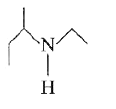Which of following compounds exists as non-resolvable racemic mixture?




The correct Answer is:D
To determine which of the given compounds exists as a non-resolvable racemic mixture, we need to analyze each compound for optical activity. A compound is optically active if it has a chiral center and lacks symmetry. Here’s a step-by-step solution:
Step 1: Understand the Criteria for Optical Activity
- A compound must have a chiral center (a carbon atom bonded to four different groups) or a chiral nitrogen (in the case of amines) to be optically active.
- The compound should not possess any plane of symmetry.
Hint: Look for chiral centers or chiral nitrogen atoms in the compounds.
Step 2: Analyze Each Compound
1. First Compound:
- Check the nitrogen atom: It has two hydrogen atoms attached.
- Since there are two identical groups (hydrogens), this nitrogen is not chiral.
- Conclusion: This compound is not optically active and thus not a non-resolvable racemic mixture.
Hint: Identify if the nitrogen has all different groups attached.
2. Second Compound:
- Check the nitrogen atom: It has an ethyl group, a different group (let's say a propyl group), and a hydrogen.
- All three groups attached to the nitrogen are different.
- Conclusion: This compound is optically active and can exist as a non-resolvable racemic mixture.
Hint: Ensure all groups attached to the chiral center are unique.
3. Third Compound:
- Check the nitrogen atom: It has two hydrogen atoms attached.
- Similar to the first compound, the presence of two identical groups means it is not chiral.
- Conclusion: This compound is not optically active and thus not a non-resolvable racemic mixture.
Hint: Look for identical groups attached to the chiral center.
4. Fourth Compound:
- Check the nitrogen atom: It has a methyl group, an ethyl group, and a hydrogen.
- All three groups attached to the nitrogen are different.
- Conclusion: This compound is optically active and can exist as a non-resolvable racemic mixture.
Hint: Confirm that the nitrogen has three distinct groups.
Step 3: Final Conclusion
Based on the analysis:
- The second and fourth compounds are the ones that can exist as non-resolvable racemic mixtures due to their optical activity.
Final Answer: The second and fourth compounds exist as non-resolvable racemic mixtures.
- A compound must have a chiral center (a carbon atom bonded to four different groups) or a chiral nitrogen (in the case of amines) to be optically active.
- The compound should not possess any plane of symmetry.
1. First Compound:
- Check the nitrogen atom: It has two hydrogen atoms attached.
- Since there are two identical groups (hydrogens), this nitrogen is not chiral.
- Conclusion: This compound is not optically active and thus not a non-resolvable racemic mixture.
- Check the nitrogen atom: It has an ethyl group, a different group (let's say a propyl group), and a hydrogen.
- All three groups attached to the nitrogen are different.
- Conclusion: This compound is optically active and can exist as a non-resolvable racemic mixture.
- Check the nitrogen atom: It has two hydrogen atoms attached.
- Similar to the first compound, the presence of two identical groups means it is not chiral.
- Conclusion: This compound is not optically active and thus not a non-resolvable racemic mixture.
- Check the nitrogen atom: It has a methyl group, an ethyl group, and a hydrogen.
- All three groups attached to the nitrogen are different.
- Conclusion: This compound is optically active and can exist as a non-resolvable racemic mixture.
Based on the analysis:
- The second and fourth compounds are the ones that can exist as non-resolvable racemic mixtures due to their optical activity.
Similar Questions
Knowledge Check
A racemic mixture is :
Aalways equimolar mixture of a pair of enantiomersBalways equimolar mixture of a pair of diastereomersCalways optically inactiveDalways optically activeWhich of the following compounds is non aromatic ?
A B
B C
C D
D
Which of the following compounds is non-aromatic?
View SolutionWhich of the following do not exist ?
View SolutionWhich of the following compound donot exist?
View SolutionWhich of the following compound (s) is/are non-polar?
View SolutionWhich of the following compound (s) is/are non-polar?
View SolutionWhich of the following compound exists as a dipolar ion ?
View Solution
